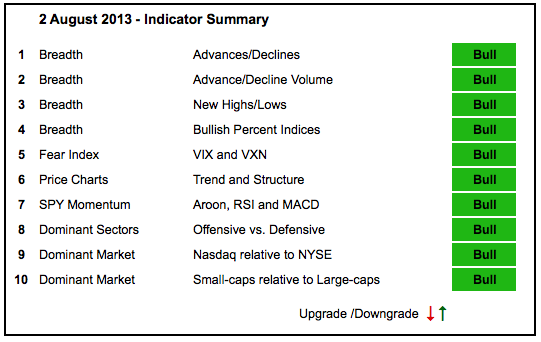The major index ETFs affirmed their uptrends with new highs this week. In addition, the Consumer Discretionary SPDR (XLY) and the Industrials SPDR (XLI) hit new highs, as did the Nasdaq AD Line and AD Volume Line. There are simply no signs of weakness in the market right now. Breadth is bullish, the trends are up, the Nasdaq is leading and small-caps are outperforming large-caps.


- AD Lines: Bullish. The Nasdaq AD Line surged to a new high in late July. The NYSE AD Line remains in an uptrend, but hit resistance near its May high.
- AD Volume Lines: Bullish. The Nasdaq AD Volume Line surged to another new high this week. The NYSE AD Volume Line hit a new high in late July.
- Net New Highs: Bullish. Nasdaq and NYSE Net New Highs remain firmly positive and their cumulative lines hit new highs.
- Bullish Percent Indices: Bullish. All nine BPIs are above 50%. The Materials BPI ($BPMATE) is the weakest at 66.67%.
- VIX/VXN: Bullish. The S&P 500 Volatility Index ($VIX) and the Nasdaq 100 Volatility Index ($VXN) are back below 15%. I will now set a big resistance zone based on the 2013 highs.
- Trend-Structure: Bullish. The major index ETFs moved to 52-week highs this week.
- SPY Momentum: Bullish. All three have been bullish since the second week of July when RSI moved back above 60, MACD(5,35,5) turned positive and the Aroon Oscillator moved back above +50.
- Offensive Sector Performance: Bullish. The Consumer Discretionary SPDR (XLY) and Industrials SPDR (XLI) are leading with 52-week highs this week. The Finance SPDR (XLF) and the Technology SPDR (XLK) are close to their prior highs.
- Nasdaq Performance: Bullish. The $COMPQ:$NYC ratio moved to its highest level since September 2012 and remains in an uptrend as the Nasdaq outperforms the NY Composite.
- Small-cap Performance: Bullish. The $RUT:$OEX ratio hit a new high in late July and remains in a clear uptrend.
- Breadth charts (here) and intermarket charts (here) have been updated.
This commentary and charts-of-interest are designed to stimulate thinking. This analysis is
not a recommendation to buy, sell, hold or sell short any security (stock ETF or otherwise).
We all need to think for ourselves when it comes to trading our own accounts. First, it is
the only way to really learn. Second, we are the only ones responsible for our decisions.
Think of these charts as food for further analysis. Before making a trade, it is important
to have a plan. Plan the trade and trade the plan. Among other things, this includes setting
a trigger level, a target area and a stop-loss level. It is also important to plan for three
possible price movements: advance, decline or sideways. Have a plan for all three scenarios
BEFORE making the trade. Consider possible holding times. And finally, look at overall market
conditions and sector/industry performance.

About the author:
Arthur Hill, CMT, is the Chief Technical Strategist at TrendInvestorPro.com. Focusing predominantly on US equities and ETFs, his systematic approach of identifying trend, finding signals within the trend, and setting key price levels has made him an esteemed market technician. Arthur has written articles for numerous financial publications including Barrons and Stocks & Commodities Magazine. In addition to his Chartered Market Technician (CMT) designation, he holds an MBA from the Cass Business School at City University in London.
Learn More





